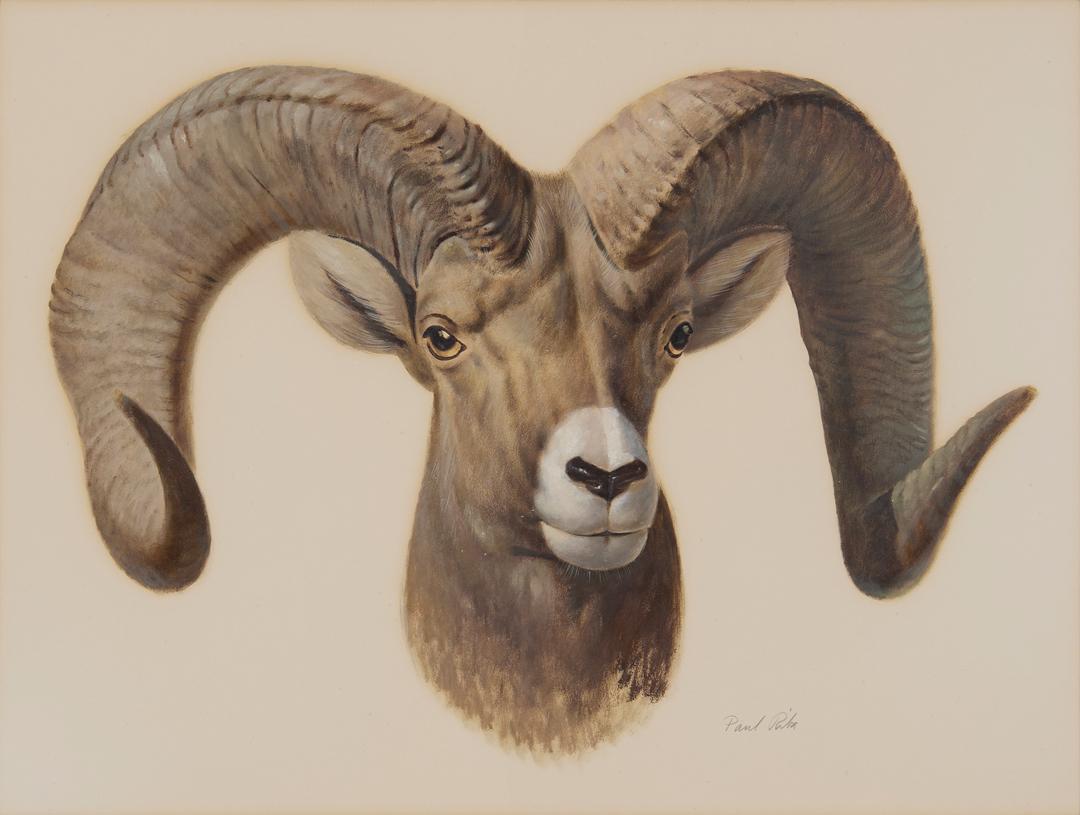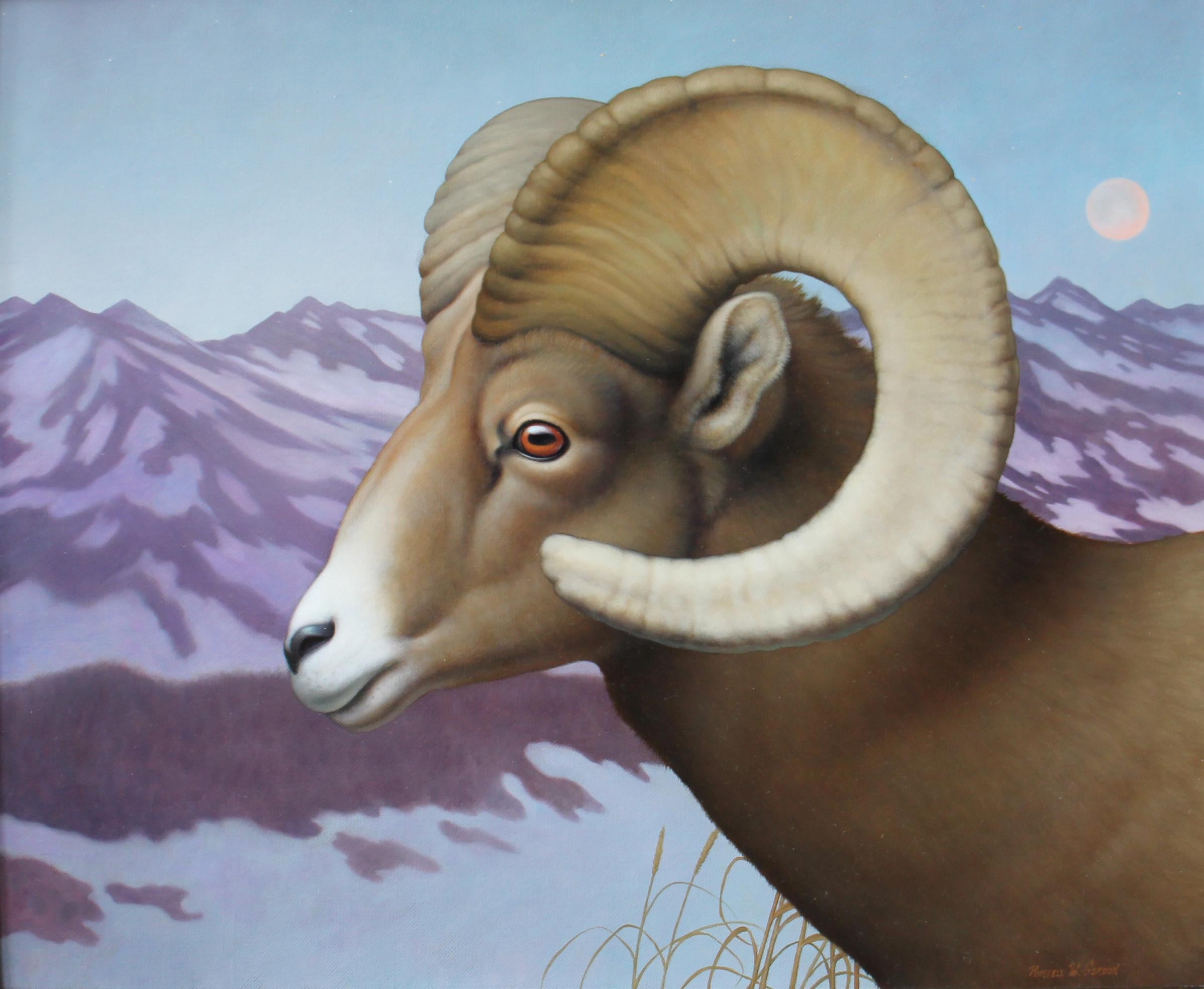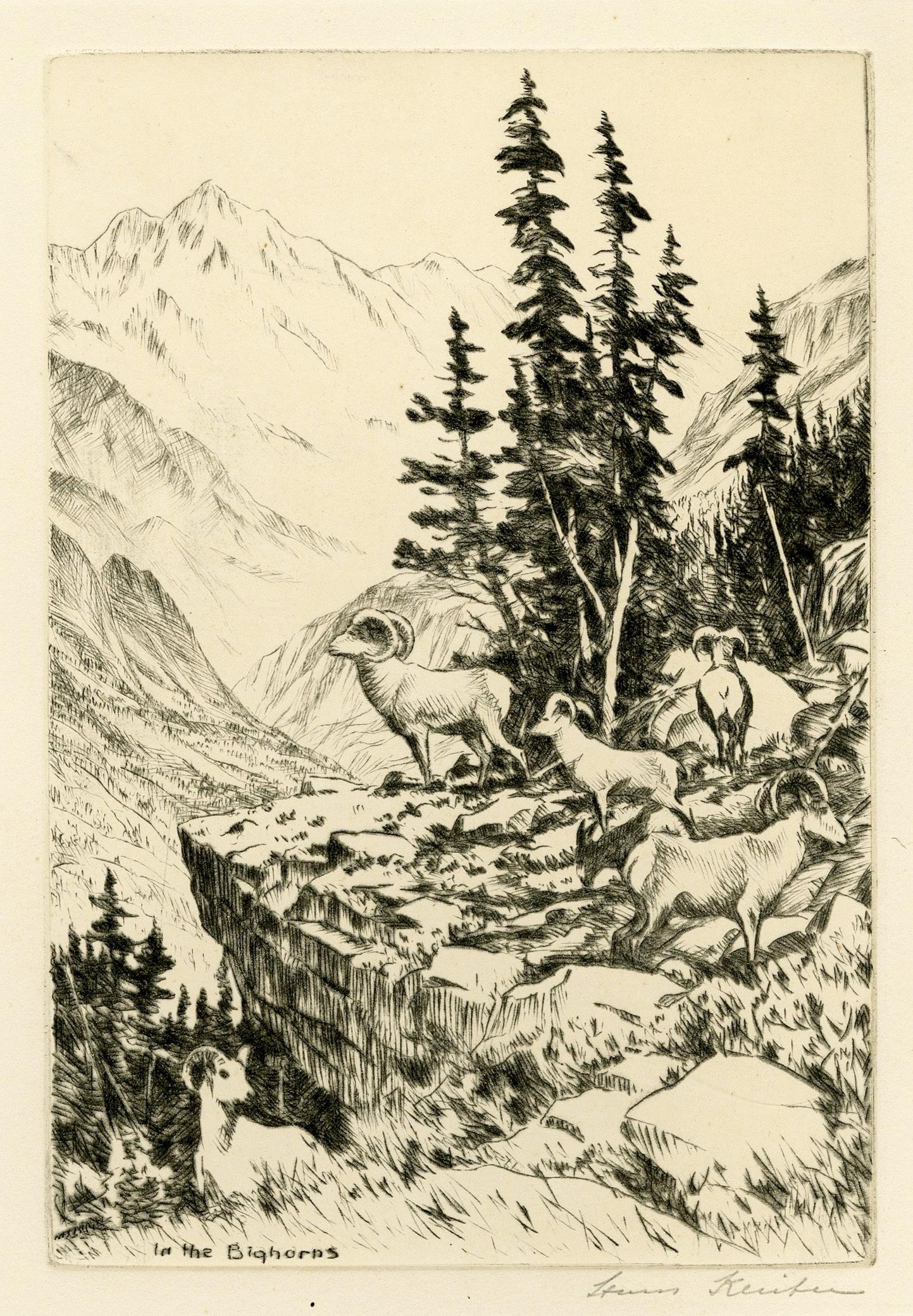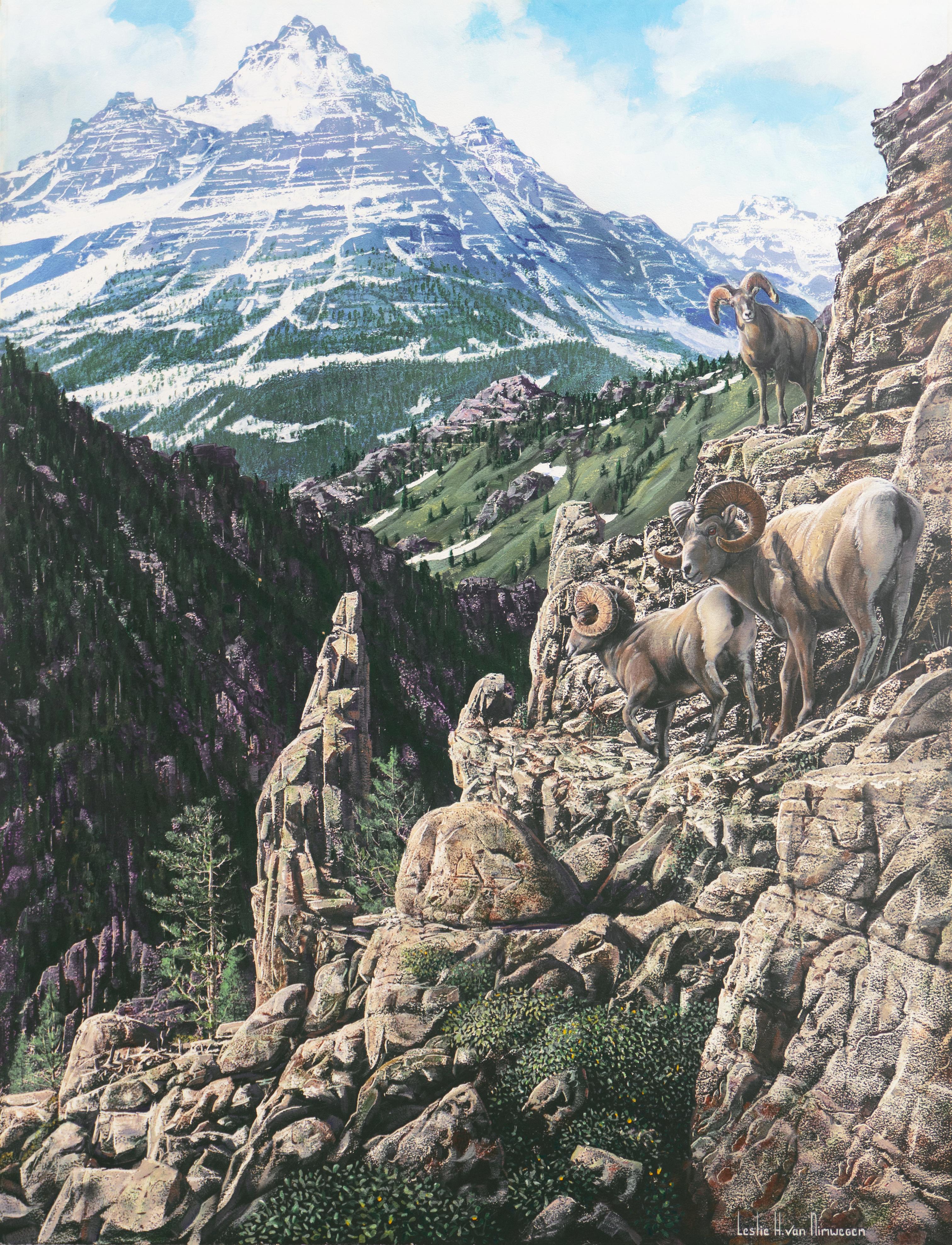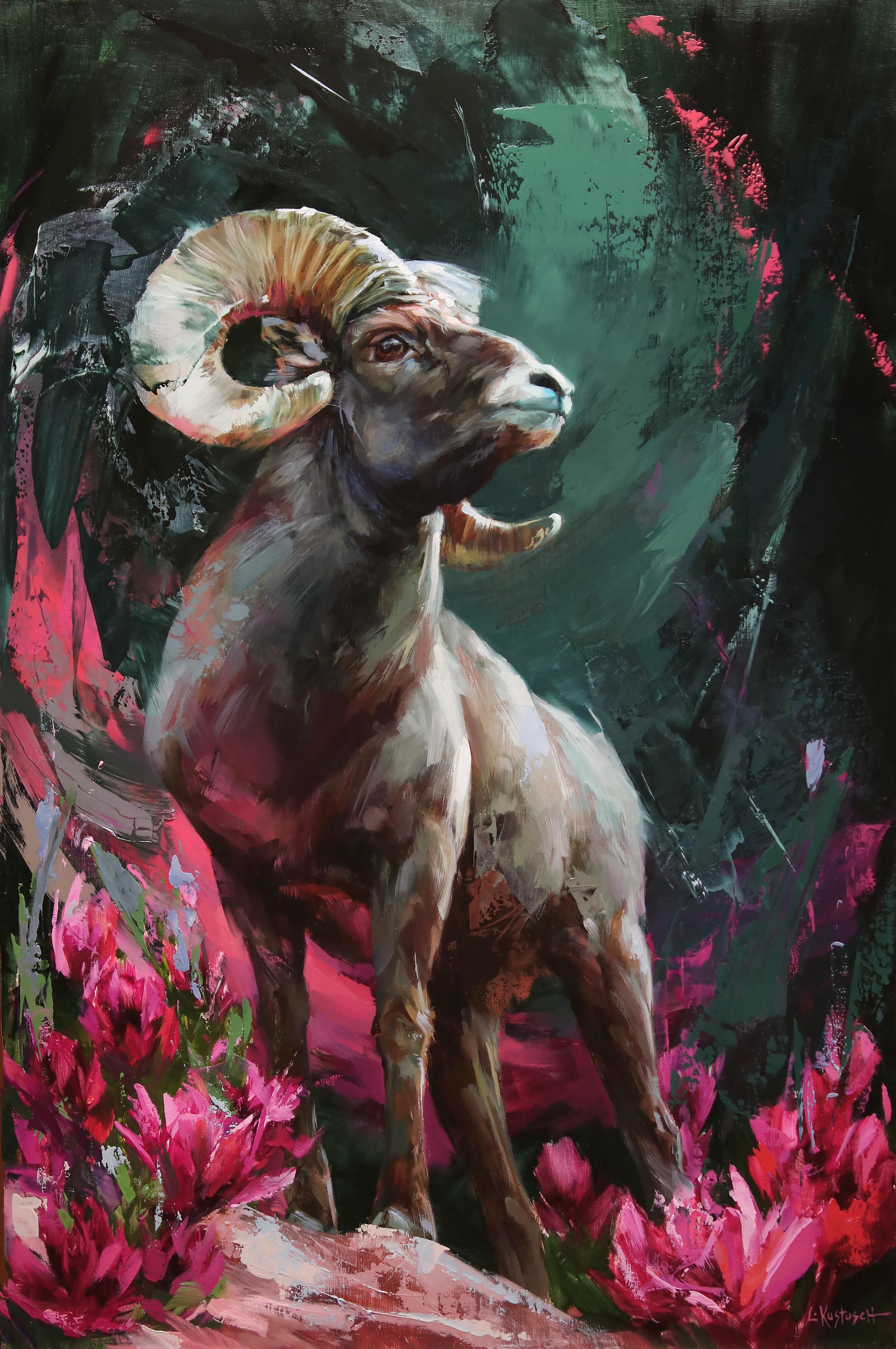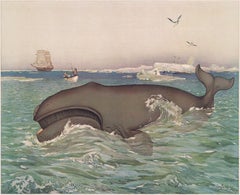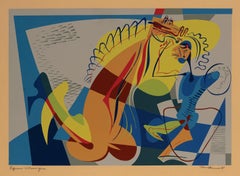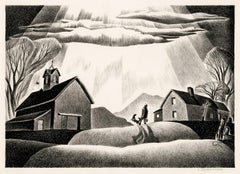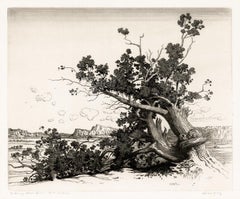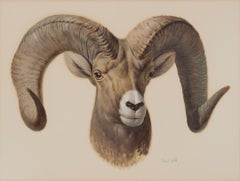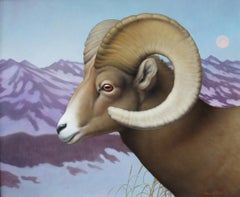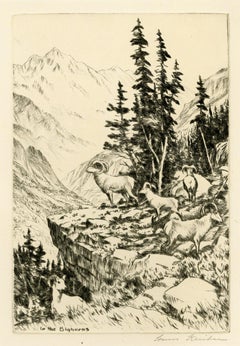Items Similar to 'Bighorn' — Mid-Century American Regionalism
Want more images or videos?
Request additional images or videos from the seller
1 of 3
William McKim'Bighorn' — Mid-Century American Regionalism1940
1940
$600
$75020% Off
£453.38
£566.7320% Off
€524.75
€655.9420% Off
CA$841.77
CA$1,052.2120% Off
A$936.29
A$1,170.3620% Off
CHF 491.18
CHF 613.9720% Off
MX$11,424.87
MX$14,281.0920% Off
NOK 6,164.89
NOK 7,706.1120% Off
SEK 5,809.66
SEK 7,262.0720% Off
DKK 3,917.07
DKK 4,896.3320% Off
About the Item
William Wind McKim, 'Bighorn', lithograph, 1940, edition c. 25. Signed and titled in pencil. A fine, richly-inked impression, on cream wove paper, the full sheet with margins (2 to 4 1/4 inches). A crease across the top right sheet corner, well away from the image, otherwise in very very good condition. Archivally matted to museum standards.
Image size 11 13/16 x 8 11/16 inches; sheet size 19 7/8 x 13 inches.
ABOUT THE ARTIST
William Wind McKim (1916-1995) was born in Independence, Missouri, and enrolled at the Kansas City Art Institute in 1934, where he studied with Thomas Hart Benton, Wallace Rosenbauer, and John De Martelly. He was awarded several scholarships during his undergraduate days and exhibited his work nationwide. He gained early acclaim when his work was included in the New York World's Fair Exhibit of Contemporary Art in 1939 when he was only twenty-three years old; he received a listing in Who’s Who in American Art that same year. He finished his undergraduate degree in painting at the Kansas City Art Institute in 1940.
McKim served in the U.S. Army during World War II and taught visual communication in the Signal Corps. He traveled extensively in the Army, primarily in the South Pacific, earning the rank of second lieutenant. He returned to Kansas City after the war to resume his artistic career.
McKim devoted himself to creating naturalistic drawings and lithographs of animals and nature, even becoming an apprentice to an expert taxidermist to deepen his understanding of animal anatomy. He stated in a 1963 article in the Kansas City Star that his “reason for wanting to draw was to capture the form and spirit of outdoor subjects.”
McKim was invited to join the staff at the Kansas City Art Institute in 1945, where he taught until his retirement in 1986. He revitalized the lithography department at the college and authored a manual on lithographic printmaking, 'Printing from Stone', and wrote several articles in the Kansas City Star on lithography.
McKim juried both art exhibitions as well as field trials for dogs. His own dogs competed and won awards in bird dog and field trial competitions throughout the 1950s and 1960s. McKim exhibited widely, including at the Missouri Pavilion at the New York World's Fair in 1964 and in many solo exhibitions at regional galleries. He designed the background for the Missouri mammals exhibit at the Kansas City Museum and spent time sketching in Jackson Hole, Wyoming; Saskatchewan and Manitoba, Canada; the eastern United States; and Mexico and Europe. McKim also contributed illustrations to American Field, the official magazine of the bird dog world, and served as president of the Heart of America Field Trial Association.
McKim’s work is held in the collections of the Albrecht-Kemper Museum of Art, the American Museum & Gardens (UK), and the Memphis Brooks Museum of Art.
- Creator:William McKim (1916 - 1995, American)
- Creation Year:1940
- Dimensions:Height: 11.82 in (30.03 cm)Width: 8.69 in (22.08 cm)
- Medium:
- Movement & Style:
- Period:
- Condition:
- Gallery Location:Myrtle Beach, SC
- Reference Number:Seller: 997351stDibs: LU532312407682
About the Seller
5.0
Recognized Seller
These prestigious sellers are industry leaders and represent the highest echelon for item quality and design.
Platinum Seller
Premium sellers with a 4.7+ rating and 24-hour response times
Established in 1995
1stDibs seller since 2016
316 sales on 1stDibs
Typical response time: 1 hour
Associations
International Fine Print Dealers Association
- ShippingRetrieving quote...Shipping from: Myrtle Beach, SC
- Return Policy
Authenticity Guarantee
In the unlikely event there’s an issue with an item’s authenticity, contact us within 1 year for a full refund. DetailsMoney-Back Guarantee
If your item is not as described, is damaged in transit, or does not arrive, contact us within 7 days for a full refund. Details24-Hour Cancellation
You have a 24-hour grace period in which to reconsider your purchase, with no questions asked.Vetted Professional Sellers
Our world-class sellers must adhere to strict standards for service and quality, maintaining the integrity of our listings.Price-Match Guarantee
If you find that a seller listed the same item for a lower price elsewhere, we’ll match it.Trusted Global Delivery
Our best-in-class carrier network provides specialized shipping options worldwide, including custom delivery.More From This Seller
View AllWhaling – Vintage Monumental Zoology Lithograph
Located in Myrtle Beach, SC
Joseph Fleischmann, 'Whaling' (Hartingers Wandtafeln: Zoologie T. XXXII), monumental vintage color lithograph, 1900. Signed in the matrix, lower right. A superb, beautifully nuanced impression, on cream wove paper, the full sheet with margins (1 1/2 to 2 3/16 inches), in very good condition. Sheet size 28 x 38 1/2 inches (711 x 978 mm). The full sheet, unmounted and unmatted—shipped carefully rolled and protected.
Rendering by A. Berger after Joseph Fleischmann. Published by Carl Gerold’s Son, Vienna, 1900.
This Artic whaling scene depicts a Greenland whale in the foreground pursued by whalers. A whaling ship is seen in the background and at right, another whale among icebergs with seagulls overhead. The print by Albert Berger...
Category
Early 1900s Naturalistic Animal Prints
Materials
Lithograph
$1,125 Sale Price
25% Off
'Equus Uirumpu' — Mid-century American Modernism
By James Houston McConnell
Located in Myrtle Beach, SC
James Houston McConnell, 'Equus Uirumpu' (The Man's Horse), color serigraph, c. 1945, edition not stated but small. Signed and titled in pencil. Initialed in the image, lower right. ...
Category
1940s American Modern Abstract Prints
Materials
Screen
'Partners' — Mid-Century Modernist Regionalism
By Dale Nichols
Located in Myrtle Beach, SC
Dale Nichols, 'Partners', lithograph, edition 250, 1950. Signed in pencil. A fine, richly-inked impression, on cream wove paper; the full sheet with margins (7/8 to 1 5/8 inches); tw...
Category
1950s American Modern Landscape Prints
Materials
Lithograph
'Old Cedars' – Early New Mexico Landscape, Southwest Regionalism
By George Elbert Burr
Located in Myrtle Beach, SC
George Elbert Burr, 'Old Cedars – New Mexico', etching, 1920, edition 40, Seeber 218. Signed and annotated '(c) George Elbert Burr Del. et Imp.' in pencil. ...
Category
1920s Realist Landscape Prints
Materials
Etching
'Taos - Relic of the Insurrection of 1845' — Southwest Regionalism
By Ira Moskowitz
Located in Myrtle Beach, SC
Ira Moskowitz, 'Relic of the Insurrection of 1845' also 'Taos Pueblo with Ruin)', lithograph, 1944, edition 30, Czestochowski 121. Signed and titled in pencil. Signed and dated in the stone, lower right. A fine, richly-inked impression, on cream wove paper, with full margins (1 3/8 to 1 15/16 inches). Very pale light toning within a previous mat opening, otherwise in excellent condition. Matted to museum standards, unframed.
Image size 11 5/8 x 15 1/2 inches (296 x 394 mm); sheet size 15 1/8 x 19 inches (384 x 483 mm).
ABOUT THE IMAGE
The Taos Revolt was a populist insurrection in January 1847 by Hispano and Pueblo allies against the United States occupation of present-day northern New Mexico during the Mexican–American War. The rebels killed provisional governor Charles Bent and several other Americans. In two short campaigns, United States troops and militia crushed the rebellion of the Hispano and Pueblo people. The New Mexicans, seeking better representation, regrouped and fought three more engagements, but after being defeated, they abandoned open warfare. The hatred of New Mexicans for the occupying American army, combined with the rebelliousness of Taos residents against imposed outside authority, were causes of the revolt. In the uprising's aftermath, the Americans executed at least 28 rebels. The Treaty of Guadalupe Hidalgo in 1850 guaranteed the property rights of New Mexico's Hispanic and American Indian residents.
ABOUT THE ARTIST
Ira Moskowitz was born in Galicia, Poland, in 1912, emigrating with his family to New York in 1927. He enrolled at the Art Student's League and studied there from 1928-31. In 1935, Moskowitz traveled to Paris and then lived until 1937 in what is now Israel. He returned to the United States in 1938 to marry artist Anna Barry in New York. The couple soon visited Taos and Santa Fe in New Mexico, returning for extended periods until 1944, when they moved there permanently, staying until 1949. During this especially productive New Mexico period, Moskowitz received a Guggenheim fellowship. His work was inspired by the New Mexico landscape and the state’s three cultures (American Southwest, Native American, and Mexican). He focused on Pueblo and Navajo life, producing an extensive oeuvre of authentic American Indian imagery. He and Anna also visited and sketched across the border in Old Mexico. While in the Southwest, Moskowitz flourished as a printmaker while continuing to produce oils and watercolors. Over 100 of Moskowitz’s works depicting Native American ceremonies were used to illustrate the book American Indian Ceremonial Dances by John Collier, Crown Publishers, New York, 1972.
After leaving the Southwest, printmaking remained an essential medium for the artist while his focus changed to subject matter celebrating Judaic religious life and customs. These works were well received early on, and Moskowitz was content to stay with them the rest of his life. From 1963 until 1966, Moskowitz lived in Paris, returning to New York City in 1967, where he made his permanent home until he died in 2001.
Shortly before his death, Zaplin-Lampert Gallery of Santa Fe staged an exhibition of the artist's works, December 2000 - January 2001. Other one-person shows included the 8th Street Playhouse, New York, 1934; Houston Museum, 1941; and the San Antonio Museum, 1941. The artist’s work was included in exhibitions at the Art Students League, Art Institute of Chicago, Philadelphia Print Club, College Art Association (promotes excellence in scholarship and teaching), and the International Exhibition of Graphic Arts (shown at MOMA, 1955).
Moskowitz’s lithographs of American Indian...
Category
1940s American Modern Landscape Prints
Materials
Lithograph
'Going My Way?' — Mid-century American Surrealism
By Robert Vale Faro
Located in Myrtle Beach, SC
Robert Vale Faro, 'Going My Way?', lithograph, 1946, edition 14. Signed in pen, recto. Titled, numbered '#118 14/14' and dated '5/5/46' in pen, verso. A fine, richly-inked impression, on heavy, off-white wove paper, with full margins (1 5/8 to 2 15/16 inches), in excellent condition. Image size 13 1/8 x 7 3/8 inches; sheet size 17 x 12 3/8 inches. Scarce. Matted to museum standards, unframed.
An impression of this work is in the permanent collection of the National Gallery of Art.
ABOUT THE ARTIST
Robert Vale Faro (1902-1988) was a modernist architect and artist associated with the Chicago Bauhaus. He received his degree in architecture and design from the Armour Institute in Chicago and worked at L'Ecole des Beaux-Arts, Paris, from 1924-27, where he was influenced by Harry Kurt Bieg and Le Corbusier. Upon his return to Chicago, Faro worked with the important modernist Chicago architects George and William Keck under Louis Sullivan.
Faro founded the avant-garde printmaking group Vanguard in 1945. The group counted Atelier 17 artists Stanley William Hayter, Sue Fuller...
Category
1940s American Modern Abstract Prints
Materials
Lithograph
You May Also Like
Bighorn Sheep, 20th Century Oil Painting by Magical Surrealist, Cleveland School
By Paul Riba
Located in Beachwood, OH
Paul Riba (American, 1912-1977)
Bighorn Sheep
Oil on paper
Signed lower right
25 x 30.5 inches
30.5 x 36 inches, framed
Paul Riba was a painter of Magic Realism. He explored the un...
Category
20th Century Surrealist Animal Paintings
Materials
Oil
"Bighorn Moonrise" by Russell Gordon, Oil Painting of Big-Horned Sheep
Located in Denver, CO
Russell Gordon's "Bighorn Moonrise" is an original, handmade oil painting that depicts big-horned sheep in a majestic purple landscape.
Russell is a r...
Category
2010s Contemporary Animal Paintings
Materials
Linen, Oil
In th Bighorns (Wyoming)
Located in Fairlawn, OH
In th Bighorns (Wyoming)
Drypoint, c. 1930's
Signed in pencil lower right (see photo)
Titled in the plate lower left
Condition: Excellent
Image/Plate size: 6 3/8 x 4 3/8 inches
Hans Kleiber (1887-1967)
Hans Norbert Kleiber, painter, etcher, illustrator, and naturalist, was born in Cologne, Germany on August 24, 1887. He emigrated from Germany to the United States in 1900, settling in Massachusetts before moving to Wyoming. Kleiber first worked in lumber camps before working for the United States Forest Service from 1906 until 1924. One of his duties as a ranger was to monitor the logging camps in the Bighorn Mountains.
Kleiber was primarily self-taught as an artist and it was in the 1920s that he began devoting himself to art. It appears that he first began to work in watercolor and oil but was producing etchings and drypoints as early as 1924. He traversed the mountains of Wyoming, Montana, and Idaho, and his subjects are drawn from the pristine landscapes and wildlife.
Kleiber's first exhibition of his etchings was mounted in 1928 at Goodspeed's Book Shop in Boston. His etching, Crossing the Platte, was included in the 1939 New York World's Fair exhibition, American Art Today. There was an exhibition of fifty of his etchings at the National Museum in 1944, and an exhibition of his watercolors was mounted at the Grand Central Galleries in New York in 1950. Kleiber was a member of the Society of American Etchers and the California Society of Printmakers. He received a silver medal in 1931 from the Printmakers Society of California for his print, Leaving the High Country...
Category
1930s American Realist Animal Prints
Materials
Drypoint
Bighorn Habits
Located in Colorado Springs, CO
Original oil painting on linen by artist Kyle Sims. Framed.
Category
21st Century and Contemporary Realist Animal Paintings
Materials
Linen, Oil
'Bighorn Rams, Rocky Mountains', Idyllwild, California Artist, Nature painter
Located in Santa Cruz, CA
Signed lower right, 'Leslie H. Van Nimwegen' (Dutch-American, born 1951) and painted circa 1990.
A large oil landscape showing a group of male bighorn rams perched on rocky crags wi...
Category
1990s Realist Animal Paintings
Materials
Acrylic, Board
"The Rocky Mountain Bighorn Sheep" Original Oil Painting
By Lindsey Kustusch
Located in Denver, CO
Lindsey Kustusch's "The Rocky Mountain Bighorn Sheep" is an expressive and evocative handmade original oil on wood panel artwork, measuring 30 x 20 x 1.50 inches. This 2023 piece is ...
Category
2010s Realist Animal Paintings
Materials
Oil, Wood Panel
More Ways To Browse
Bird Dog
Thomas Hart Benton Lithographs
Thomas Hart Benton Signed Lithograph
C C Mckim
John S De Martelly
Audubon Engraving
Intaglio Bird
Retro Flamingo Art
Basquiat Dog
Charles Darwin
Woodblock Bird Prints
Maria Sibylla Merian
John Finch
Gerald Summers
Karel Appel Cat Lithograph
Haiti Antique
Barn Owl
Michael Logan
